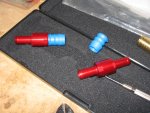[MENTION=2268]GoMax[/MENTION]
The hose you call #2 is not a vent but the inlet air side of the PVC system.
I do not understand where everyone thinks there is boost pressure in the valve cover?
How would it get in there?
Remember that any pressure in the valve cover would also be in the oil pan.
If this were the case, we would all be ok launching dip sticks through the hood.
If you believe that you have a high enough pressure caused from blow by, then you have a more serious problem then the need for a catch can.
BTW, that PCV inlet hose is baffled in the valve cover.
Although I can see how some air can be siphoned into the turbo.
But if there were a lot of oil, it would be all over the compressor impellor and I have never heard of this.
Dave
Dave,
I may not have been clear - and for that I apologize.
My understanding is the the Positive Crankcase Ventilation system is always trying to vent the crankcase when the engine is running.
When the engine is at idle, the intake manifold is under vacuum, and the air is vented thru line #1.
My understanding is when the engine is under boost (at the intake manifold), the crankcase air still has to go somewhere.
Since line #1 is basically closed (from the PVC valve), the crankcase air can't exit via line #1.
In these conditions, I believe the venting must happen via line #2.
(You mention that Line #2 is an air inlet - and it very well may be - I am not totally sure WHAT line #2 is doing... to be honest!)
Line #2 isn't under boost, its under vacuum. From the intake side of line #2, we would see a vacuum (basically nil at idle, but higher under boost), and air would be pulled from the valve cover to the intake stream. No pressure to launch our dipsticks into orbit - thank goodness!
In line #1, when that line is under vacuum, we use an OCC to catch the excess oil, and prevent it from entering the intake.
In line #2, when that line is under vacuum, we.....do nothing....... my question was centered around if the second OCC was needed or not...
Clearly if Line #2 has an internal baffle, then they are already trying to contain that oil in the valve cover area, and prevent it from entering the Intake.
My questions was merely to confirm my understanding, and to see if we might need a second OCC.
From your statement, it seems like there is little if any evidence of a need.
(And I freely admit I could absolutely be completely befuddled and modeling this wrong - sorry if that is the case!).
--- Max




![Mad [}(] [}(]](/images/smilies/mad.gif)